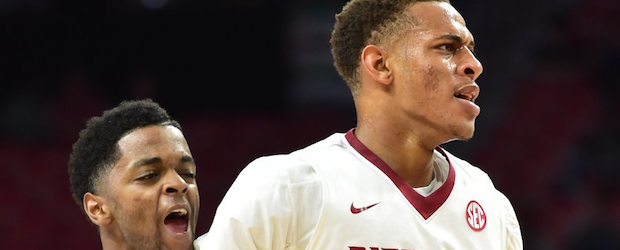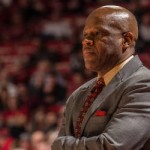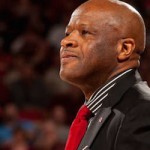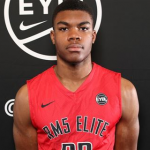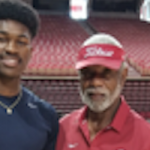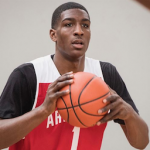 As the Arkansas Razorbacks enter their seventh basketball season under the leadership of Mike Anderson, the upward trajectory of the program may not be evident to the majority of national college hoops analysts, it’s certainly not with most in the SEC-football-first-minded media (that includes local), and even among many Hog fans the attitude is “Wake me when we get to the Sweet 16.”
As the Arkansas Razorbacks enter their seventh basketball season under the leadership of Mike Anderson, the upward trajectory of the program may not be evident to the majority of national college hoops analysts, it’s certainly not with most in the SEC-football-first-minded media (that includes local), and even among many Hog fans the attitude is “Wake me when we get to the Sweet 16.”
You can’t really blame those who are on the outside looking in for not recognizing that the program is turning a corner on its way back to relevance. Not nationally, not in the SEC, not even at home among Arkansas fans who remember what greatness tasted like. Because for all the positives Anderson has authored after fishing the program out of a dumpster fire in 2011, he still hasn’t strung together enough lightning-strike moments to conjure serious comparisons to the storied program’s best days or inspire empassioned belief that a return to some semblance of that greatness is imminent.
I’m not suggesting that Hog fans’ belief in their hoops program isn’t growing stronger, because it is … but it still feels more like cautious optimism than it does unswerving belief. And this is no knock on Anderson or his program, because I believe he and his staff have done an admirable, effective job of positioning the Razorbacks to be among the top 2-3 teams in the SEC consistently. But after six seasons, there’s still no signature moment on the national stage.
A win over No. 1 seed and eventual national champ North Carolina for a Sweet 16 berth back in March would have done the trick. It would have sparked and fueled a raging oh-yeah-we’re-back fire among Hog fans everywhere, and it would have served notice to the national and SEC talking heads that Arkansas was no longer lingering in Where Are They Now? pergatory. All of that almost happened. The Hogs were so close to having a Paul Eells “Oh my” happy ending against UNC, but a 5-point lead with 3 minutes left evaporated in a Tar Heels’ ref-aided win, and with it so did any chance that SEC Network basketball broadcasters would finally abandon their tired mantra that Arkansas struggles to win on the road.
Seriously, Arkansas is one of only two SEC programs with a winning record in SEC road games over the past three seasons, yet from the network that does not have a single stock clip of the Hogs in its current preseason SEC hoops promotional ads that have been airing during football-game TV timeouts, no one should be surprised that they’re still stuck on the 4-seasons-ago narrative that the Hogs can’t get over the hump on the road.
Folks, the point is sometimes there’s a fine narrative-line between breaking through to being relevant on a national stage and remaining as a perceived bobbing-along, once-proud program that is perpetually treading water in a football league. If it’s back to the drawing board, this time the goal is to stop knocking on the door of national relevance and finally kick it down.
The architect of the Fastest 40 believes it’s coming.
“Our culture is set for winning,” Anderson said in early October as the Hogs began practice to kick off the 2017-18 season. “We are in a place where this thing is going to take off.”
In a sense, the culture of winning has already been launched.
After a 5-season drought of ZERO postseason basketball appearances beyond the first game of the SEC tournament (John Pelphrey’s final three seasons and Anderson’s first two), the Hogs have advanced to the postseason in 3 of the last 4 seasons under Anderson’s guidance. That’s an NIT appearance in 2013-14 and NCAA tournament appearances in ’14-15 (27 wins, 2nd-place finish in the SEC, SECT finals, and final Top 20 ranking) and ’16-17 (26 wins, 3rd-place finish in the SEC, SECT finals).
In the past three seasons, Arkansas is second only to Kentucky in the SEC in total wins, SEC wins, SEC road record, SEC tournament finals apperances, and NCAA tournament appearances.
All of that is significant improvement for Arkansas compared to where it had been for most of the 21st century. But again, even if perception is that the program improving and getting closer to Anderson’s vision of breaking through, it’s going to take winning the SEC, a Sweet 16, or something that moves the needle further than the strides made in recent seasons for Arkansas to really get back on the map nationally.
In 2017-18, the stars could be aligning for such a move up. The schedule is the toughest of the Anderson era, both the non-conference and the 18-game slate in the SEC (which got three teams into the Elite Eight last season, and it appears the league could be the strongest its been in years). Plus, Arkansas is one of only a handful of teams in the country that returns six seniors. Those are the slippery-slope, could-be positives that can also take a wrong turn.
In the next few sections, we’re going to look at the schedule and the roster (who’s gone, who’s back, who’s new), then we’re going to project how the 2017-18 season might play out for the Arkansas basketball Razorbacks.
The Schedule
Arkansas has lined up it’s toughest non-conference schedule to date under Anderson. The Phil Knight 80 Invitational in Portland over Thanksgiving Day weekend offers three potential match-ups against high-major programs, starting with a guaranteed first-round game against Oklahoma with preseason No. 9 North Carolina the likely second-round reward (revenge game, anyone?) if the Hogs can get past the Sooners. Michigan State (preseason No. 2), Oregon, UConn, and DePaul are all possibilites for the Hogs’ third and final game in Portland.
And three November home games — Samford tomorrow night, Bucknell on Sunday, and Fresno State on Nov. 17 — that precede the PK80 event won’t be easy. December home games against Minnesota (preseason No. 15), Colorado State, Cal State Bakersfield, and Tennessee (Arkansas’s second-consecutive year to start SEC play in December at home) all offer more NCAAT resume builders, as do a road game against Houston in December and a rematch in the Big 12/SEC Challenge when Arkansas hosts Oklahoma State in January.
In the SEC, both Kentucky and Florida are preseason Top 10 teams, and the Hogs play the ‘Cats at home and the Gators on the road. A talented and veteran Texas A&M squad is ranked No. 25 in the preseason AP Top 25, and Hogs-v-Aggies is an annual home-and-away series that would likely benefit Arkansas this season if it can just earn a split. Missouri has emerged from being SEC doormat to a media darling in the offseason after Cuonzo Martin was hired and started signing 5-star and high-4-star prospects. The Tigers are among the top 5 or so teams “receiving votes” but not ranked in either national poll (AP and Coaches), and this is another annual home-and-away series that all of a sudden could have a significant impact on the top third of the SEC pecking order, not just in the standings but in RPI.
Alabama is No. 25 in the Coaches Poll, and though the Tide is without prized 5-star point guard Collin Sexton to start the season, this road game for Arkansas could be a notch in the NCAAT resume with a win. Vanderbilt was one of five SEC teams to make the NCAAT last year, and the Commodores appear headed for another top-half of the league finish in ’17-18. Hogs will get them at home again, but that did not work out last year as the ‘Dores lone win against Arkansas in three tries was in Fayetteville, and convincingly so that night. Mississippi State was one of the youngest teams in college basketball last season, and though the media picked MSU to finish toward the bottom of the league, Ben Howland has recruited well and the Starkville ‘ Dogs may be ready to step up to the top half of the league and fight for an at-large bid.
South Carolina broke through in ’16-17 and made it all the way to the Final Four, but the Gamecocks lost several key starters to graduation and the draft, so in a tougher-than-usual SEC I’m not counting on USC-E making the top half of the league in ’17-18, but I’m also not counting them out. Georgia and Ole Miss are always tough, seemingly always no worse than on the NCAAT bubble, so I could see one or both teams making a push. LSU, Tennessee, and Auburn are my picks for the bottom of the league, but who knows.
That’s 9 league teams not named Kentucky or Florida that probably have better than a puncher’s chance to cash in an at-large bid to the Dance. So, the Razorbacks have plenty of opportunities in what looks like the deepest SEC in terms of NCAAT at-large bid potential. If the league can go from 5 NCAAT bids last year to, say, 6 or 7 this season, Arkansas could be in good shape.
The Roster
Let’s start by looking at who’s gone. Three departed seniors from the ’16-17 team will be missed and not easily replaced. Moses Kingsley was twice All SEC 2nd-team and last season was SEC Defensive Player of the Year. Dusty Hannahs was twice Top 10 in the SEC in scoring, he scored over 1,000 career points at Arkansas in only two seasons, and he was the most creative halfcourt scorer at Arkansas since Joe Johnson. Manuale Watkins was the glue guy on the team, a tough-minded player who rolled his sleeves up and filled many roles while also being a leader and captain.
Those three were intregal parts of teams that won a total of 69 games and advanced to 2 SECT finals and 2 NCAATs in the past three seasons. You don’t just replace their value overnight, no matter how talented your incoming recruits are, so there will be some growing pains early against a tough non-conference schedule. Freshman forward Brachen Hazen is also gone, transferring to Ball State after barely getting off the bench last season. Redshirt walk-on freshman guard R.J. Glasper also transferred, opting to continue his career at Arkansas Tech.
Look who’s back … back again. Fringe All SEC guards Daryl Macon (6-3 combo guard) and Jaylen Barford (6-3 combo guard) have returned to Arkansas for their senior seasons after initially declaring for the NBA draft to test the waters and get feedback on their pro potential. In their first season removed from the junior-college ranks, Macon and Barford were two of Arkansas’s four double-figure scorers by average last season, and both were key in the Hogs’ surge in the final third of the season on their way to 26 wins, the SECT finals, and the NCAAT as an 8-seed.
Macon, who alternated starting and coming off the bench, was probably Arkansas’s best overall player when you look at the arc of the ’16-17 season. For one, he was the best closer on the team, particularly in the way he could draw fouls late in tight games and then cash in the dagger-freebies at an ice-water-in-veins clip (86.6% last season). He was one of the best shooter-scorers in the SEC when you combine volume and efficiency in two-point field goals, 3-pointers, and free throws. Macon has an alpha mentality with the ball, carrying an air of confidence as he sizes up his defender before getting into his bag. There are times he settles too soon for a 3-point attempt, because he’s so effective as a slasher and pull-up mid-range shooter who, again, can manufacture trips to the foul line. In the two exhibition games, he averaged 32.5 minutes, 22.5 points (50% field goals, although only 35.7% from 3, and a perfect 16-of-16 from the FT line), while also totaling 9 assists, 5 rebounds, 3 steals, and 4 turnovers. A vocal player with personality and charisma, Macon looks to be the front man for a team that returns six seniors.
Barford, who came in as the No. 1 rated juco player in the country, got off to a slow start in the non-conference — he struggled with turnovers, shot selection, and overall decision-making — before turning a corner in conference play. In a come-from-behind win at Tennessee in Arkansas’s second SEC game, Barford had a big stretch of bucket-making at all 3 levels, and that seemed to propel him for the rest of the season. Down the stretch, probably the final third of the season when the Razorbacks finished strong, Barford was the most difficult matchup for teams to deal with against Arkansas. His tough-bucket makes on drives to the rim, post-up and step-back mid-range shots, runners and pull-ups, and improved 3-point shooting really emerged over time, and though he still had some struggles with over-dribbling and turnovers, his spurt-ability to score in bunches in a variety of ways was huge for Arkansas. In the two exhibition games, he virtually matched Macon’s production: 35.0 minutes, 21.0 points (64% FGs including 5-of-9 from 3, and 5-of-7 FTs for 71.4%), plus a total of 10 assists, 8 rebounds, 2 steals, and 4 turnovers.
Offensively, through the Red/White scrimmage and two exhibition games, Macon and Barford have been on point for the most part, showing added complexity in their scoring arsenals while deferring smartly to set up others. Defensively, both players should be better and need to be better for Arkansas than they were last season, but in the preseason their defense has been a bit of a disappointment as opposing guards have been free to roam — to penetrate, score, facilitate, and shoot from 3 with breathing room. That’s not all on Macon and Barford, but as the team leaders it’s on them to lead at both ends of the court.
Leaving behind a legacy of winning. Talk about building a winning culture, it takes all hands on deck — from the starters and go-to guys on down to the role players. For seniors Trey Thompson (6-9 forward) and Anton Beard (6-0 combo guard) — two important career role players to this point — they hope to leave Arkansas with three NCAAT appearances in their four years in the program. After playing complementary roles in the Hogs’ previous success, now is the time both are being counted on to step up and take their contributions to another level. In the preseason, both started and played heavy minutes.
For Beard, his road to this point has not always been easy, but it appears he’s in the best shape of his career. Beard is at his best when he finds a balance between facilitating for others while limiting turnovers and taking good shots. That sounds like a formula for success for anybody, but Beard has made his biggest positive impact in games when he’s efficient while minimizing his shot-attempt output. Last season as a junior, he shot career bests from the field (40.4%) and the 3-point line (35.6%), numbers that suggest he’s better off setting up others while being more selective in creating his own shots. Beard joined Macon and Barford as the only Hogs to score in double figures in both of the exhibition games. In the two games combined, Beard played 70 minutes (35.0 per) and scored 24 points (12 points in each game) on 6-of-19 field-goal shooting (31.6%) while dishing out 7 assists and turning the ball over 7 times. The positives were 40% shooting from 3 (4-of-10) and a perfect 8-of-8 at the free throw line, but poor shot selection and not taking care of the ball are concerns for a senior guard being counted on to help the program to back-to-back NCAATs for the first time this decade. I think the Hogs are best served if Beard can improve his shooting to somewhere between 40% and 45% while keeping attempts down around the 6-to-8 per-game range, and if he can get an assist-to-turnover ratio around 2-to-1. Defensively, he’s a clever help defender, but on-ball has been a struggle.
There are plenty of advanced stats out there that show Thompson has been an efficient scorer and playmamker for others, but the big question now is he can produce and be efficient in a much higher volume of minutes? In the two exhbition games, Thompson — who’s a gifted, smart passer from the low post but especially out on the floor — played a total of 56 minutes (28.0 per), but managed only 6 points total on 2-of-6 field goals and 2-of-2 free throws. He did gobble up 13 rebounds with 4 assists, and though nobody expects him to score the ball as much as Kingsley did the past two seasons, he at least needs to be more aggressive in taking good, open shots that he too often passes up.
With their minutes going up, Beard and Thompson must find ways to be efficient and productive. Macon and Barford will provide the bulk of the firepower offensively, but they can’t do it all on their own, and that means Beard’s got to be smart and selective and Thompson’s got to be more aggressive so that teams have to account for them, too.
Sophomores step up? After showing promise in very limited opportunities as freshmen last season, C.J Jones (6-5 shooting guard) and Adrio Bailey (6-6 combo-4) are in great spots to earn more minutes with meaningful roles. Both bring assets to the table that are unique.
Jones looks to be Arkansas’s best catch-and-shoot weapon since Anthlon Bell, except Jones is two inches taller, much more athletic, a better rebounder, and has the potential to be better defensively. Jones showed flashes of being an efficient volume-scorer during the Hogs’ exhibition tour in Spain back in August 2016, then he showed more of the same in the last two Red/White games. In the last two exhibition games, however, Jones averaged 22.5 minutes and 6.5 points (5-of-12 FGs including 3-of-9 from 3) while totaling 7 rebounds, 3 assists, and 5 turnovers. Jones is at his best in catch-and-shoot and one-dribble-and-pull-up scenarios, and he tends to turn the ball over when he tries to create off the dribble. He’s a bouncy rebounder and can finish above the rim, so his value goes beyond his perimeter shooting skill. Defense was not a strong suit as a freshman, and in the preseason he sometimes looked hesitant or a step slow to react and move his feet. With three senior guards in line for big minutes, 6-to-8 efficient points per game from Jones playing with the second unit looks like a reasonable contribution to help the team.
Bailey needs to be a “junkyard dog,” at least that’s what Anderson said in his Samford-game-preview press conference on Wednesday. Energy, toughness, explosiveness, and playing with a high-motor are the key ingredients in Bailey’s game as an undersized interior player. His spirited effort in that close call against North Carolina in the third round of the NCAAT is the blueprint for what he needs to bring to the table every night out. He struggled in the preseaosn, though, when it looked like he was thinking too much and trying to do too much. In the two exhibition games, he started and averaged 18.0 minutes 3.5 points (2-of-6 FGs and 3-of-8 FTs) while totaling 10 rebounds and 4 turnovers. For those clamoring to see Bailey as the regular starter at the 4-spot, he might not be ready for that role just yet.
Between Jones and Bailey, the Hogs don’t need a couple of heavy-minute starters, but they do need dependable role players who can complement a veteran lineup and infuse energy coming in with the second unit and providing quality minutes.
Senior forwards on the shelf … for now! The last thing you want from your players in their last go-round is for them to be in street clothes on the bench and in the dog house, but that’s where Dustin Thomas (6-8 forward) and Arlando Cook (6-8 forward) find themselves to begin the season. Cook recently returned to practice after an indefinite suspension from all team activities, but he remains suspended from playing in games until his off-season legal matters are resolved through the judicial system. Thomas has missed both exhibition games, and reportedly will miss the first three regular-season games while serving a suspension for what Anderson said was a violation of team rules.
At a position that was up and down last season with three newcomers splitting time, Thomas emerged as the most consistent and reliable option at the combo-4 spot. He played his best basketball in the final third of the season, including a clutch 13-point, 5-rebound effort in a tight win over Seton Hall in the second round of the NCAAT. Thomas has decent handling and face-up skill, and he shot an efficient 48.6% from the field last season. Assuming Thomas takes his minutes up from 18 to 25 per game, it’s conceivable he could contribute 7-8 points and 4-5 rebounds per game. Cook has his moments last season (close road wins against Texas, Texas A&M, and Tennessee come to mind), and certainly Arkansas could use him in the frontcourt rotation sooner rather than later.
Freshman class is all about size, length, athleticism, and high court IQ. Daniel Gafford (6-11 center with 7-2 wingspan and plus-athleticism), Darious Hall (6-6 small forward / wing with 7-0 wingspan and plus-athleticism), Khalil Garland (6-5 combo guard with 6-6 wingspan and plus-athleticism), and Gabe Osabuohien (6-8 combo-4 with 7-1 wingspan and good athleticism) not only meet the eye test, but all are capable of helping Arkansas now and/or in the near future.
Gafford, a national Top 35 recruit last season at El Dorado high school, has a 5-star combination of size, length, and athleticism. Soft but strong hands, runs the floor easily with long strides. I’ve always said he plays on a pogo stick, because he can bounce high and gets off the floor quickly — once, twice, three times in a matter of seconds … whatever it takes to gobble up rebounds, block shots, and dunk everything that comes near his zip code. Gafford also plays with attitude, there’s a little mean and nastiness to his game. He dominated the Arkansas high school basketball scene last year, averaging 17-plus points, 16-plus rebounds, and nearly 8 blocks per game. A double-double machine, Gafford also recorded a dozen or so triple-doubles as a high school senior. In a head-to-head matchup back in January against North Carolina freshman big man Garrison Brooks (a 4-star forward that Arkanas offered last year), Gafford blew up with 25 points, 20 rebounds, 8 steals, and 6 blocks while limiting Brooks to 12 points on just 3 field goals.
Gafford arrived in Fayetteville in late May and has put on at least 15-18 pounds of muscle to get to his current weight of 235. He immediately began opening eyes and turning heads on the floor during offseason workouts and limited practices, and his Razorbacks teammates and coaches have already used descriptors like “freak” and “special.” In the preseason, Gafford looked ready for the moment. In the two exhibition games, he averaged 20.5 minutes and 11.0 points (8-of-11 FGs and 7-of-13 FTs) while totaling team-highs of 15 rebounds and 5 blocked shots. He also had 3 steals and only 5 personal fouls.
The only Hog to start every game of his career was Bobby Portis, and I think Gafford should be the next. Anderson prefers to rely on his seniors and give them the bulk of the starts, but Gafford impacts the game at both ends of the floor in ways that nobody on the roster can. His offensive skill is a work in progress, but his productivity on the glass, blocking and altering shots, and scoring off putbacks, lobs, and just outworking other bigs is already good enough to earn him starter minutes. Gafford looks like a future pro with All SEC potential early in his career.
Hall is already being compared to Watkins as a glue-guy, and though that’s probably true at the moment, Hall projects to be more like a Michael Qualls in terms of production, impact, and All SEC potential. He missed the first exhibition game due to concussion protocol after a head-to-head collision in practice, but bounced back nicely with 16 minutes, 6 points (2-of-4 FGs and 2-of-2 FTs), 4 steals, 3 rebounds, and 3 blocks in the last exhibition game.
Hall, who led Little Rock Mills to the 5A state title last season, said early on that his goal was to make the SEC All Freshman team. He has a high basketball IQ and plays with a slash-and-crash mentality. He has some guard skills mixed in with forward physicality, and that translates defensively, too, because he can keep pace with guards and bang inside with the bigs. On a team that struggled defensively last year on the perimeter, and also struggled on that end in the two exhibition games, Hall could earn starter minutes as soon as the PK80 event later this month.
Garland has not been cleared medically to go through full-contact practices. He’s been withheld from games and will continue to sit out until he’s cleared. He’s a 5-star finisher in transition, one of the best open-court players I’ve seen on the high school level. Also a big-time slasher in the half-court, plus he has good enough handles and facilitator instincts to help out as a combo guard. Mid-range shot is effective, and he hit better than 45% on 3-pointers in limited attempts as a high school senior at Little Rock Parkview. Like Hall and Gafford, Garland is another above-the-rim performer with a high basketball IQ who has All SEC potential down the line.
Osabuohien was a late addition in the ’17 class. A Toronto native, he spent his senior high school season at Southwest Christian Academy in Little Rock. When Hazen announced in May that he would transfer, a spot came open and Arkansas was quick to pursue Osabuohien. He’s a versatile defender in his own right, able to guard on the perimeter and inside. He also has some perimeter skill on the offensive end, and is a good passer. With Thomas, Cook, and Bailey all ahead in the combo-4 spot pecking order, Osabuohien will likely play a limited role off the bench as a freshman, but his upside is good for a key role in the future.
The Outlook
Before we jump off and start making projections, let’s consider a few more things …
- Given the apparent upgrade and quality of Arkansas’s schedule — both non-conference and SEC — 22 or 23 wins might offer as much RPI / SOS / BPI value as the 27- and 26-win teams got. Win totals are not as important as quality wins and playing strong competition away from home, and the Hogs’ schedule checks a lot of boxes with some sexy matchups. Will the schedule live up to what it looks like on paper, and can the Hogs finish the final third of the season as well as they did in ’14-15 and ’16-17?
- In Anderson’s system, it’s not always about who starts as much as it is who plays starter minutes and finishes games. However, as stated above, Gafford is a Day One starter if it’s up to me, and Hall should already be on the cusp of having a big role, too. They’re match-up luxuries for Arkansas, problems for opponents, and in just one exhibition game on the floor together, they showed a lot of promise on the defensive end, combining for 11 rebounds, 8 blocks, and 4 steals while causing more disruption with deflections and altered shots. How soon does Anderson hand these guys the keys in the name of getting better defensively?
- Speaking of D, Arkansas was not a good defensive team last season, but it’s offense was and that put pressure on teams to exert great effort and energy on defense in hopes of slowing pace and affecting efficiency. With half of Arkansas’s double-figure scorers gone, who steps up to take pressure off Macon and Barford? Is it a committee effort?
- The Hogs were a good 3-point shooting team last year, but did not shoot a high volume from range because they had guards who were comfortable slashing and finishing or getting to the FT line, where they were a blistering 78-ish-% as a team. The makeup of this team is a little different, and athletic/active interior players like Gafford and Bailey stand to get plenty of opportunities at the free-throw line. Both have struggled shooting freebies, and if excellence at the line won a few games for the Hogs last year, is there a concern that some games might slip away if the young bigs continue to struggle at the line?
- Anderson has already expressed concerns about his team’s pace on offense, passing the ball, taking care of the ball, rebounding, and bench depth with a roster that is currently short-handed. How many of these are quick fixes that get resolved in short order, and which ones hang out there all season as potential thorns in the Hogs’ plans?
- Last season’s team had a solid mix of 3 seniors and 6 juniors — truly a veteran team. And though this team has twice as many seniors as last year’s team, half of the six are only in their second season in the program, there is no junior class, the sophomores played very little and are effectively freshmen, and the freshmen are talented but brand new to the college game. Is this really a veteran team?
Projection time! Factoring the schedule, the personnel loss, the talented-but-inexperienced newcomers, early depth issues, unknowns in terms of defensive improvement and scoring replacement, and what I’ve seen so far with my own eyes — among other things — I’d say this is a 19-to-23 win team (9-9 to 11-7, best-case 12-6, in SEC play) that will likely finish anywhere from 4th to 7th in the SEC. The high end in that range could mean as good as a 5- or 6-seed as an NCAAT at-large bid, and the low end probably means being squarely on the bubble. The home schedule offers some nice resume-building opportunities (Kentucky, Minnesota, Texas A&M, Missouri), the road and neutral games are also loaded with similar opportunities. Regardless of the overall record or league finish, like most Anderson-led teams, I see this one playing its best basketball in the final third of the season, and I think that leads to making the NCAAT for the third time in the past four years. Playing this kind of schedule probably prepares Arkansas better for postseason play. Many factors (seeding, matchups, injuries, and good or bad bounces all come to mind) play into suriving and advancing in the NCAAT, so I won’t go so far as to predict a Sweet 16. But, I do think the pieces are in place to go further this year. Macon and Barford are all-league on the offensive end to be certain, and I think Gafford and Hall are going to be hammers, especially on defense. If those four come through big with Beard, Thompson, Thomas, Cook, Jones, and Bailey all improving compared to last year, this team’s got a shot at playing into the second weekend of the Dance. And wouldn’t that be a fine, signature moment on the national stage for the Fastest 40?!


